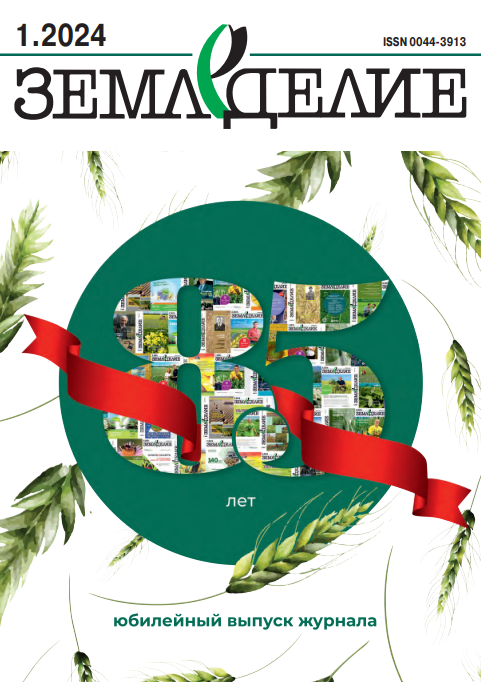Продуктивность пшеницы озимой в зависимости от предшественников в условиях Крыма
Земледелие, 2016, № 5
УДК 633.11
В.С. Паштецкий , доктор сельскохозяйственных наук, врио директора
Адрес электронной почты защищен от спам-ботов. Для просмотра адреса в вашем браузере должен быть включен Javascript.
Л.А. Радченко , кандидат сельскохозяйственных наук, зам. директора
К.Г. Женченко , старший научный сотрудник
Научно-исследовательский институт сельского хозяйства Крыма, ул. Киевская, 150, Симферополь, 295493, Российская Федерация
Наибольшие урожаи пшеницы возможны при соблюдении технологии, один из основных элементов которой – предшественник. Цель наших исследований – определение роли предшественников в повышении урожайности пшеницы озимой в степной зоне Крыма. Работу проводили в стационарном опыте в пяти севооборотах на полях НИИСХ Крыма, расположенных в южной крымской степи, в 2006-2015 гг. Почва опытного участка чернозем южный малогумусный (2,0-2,3% гумуса). Предшественниками пшеницы озимой в севооборотах были пары чистые и занятые (яровыми и озимыми зернобобовыми), горчица, зернобобовые (нут и горох), рапс озимый и пшеница озимая. За первую ротацию содержание продуктивной влаги по чистым парам в среднем составило 58,8 мм, по занятым – 40,2-37,4, по зернобобовым и горчице – 30,0 и 35,7, по рапсу и пшенице озимой – 27,3 и 25,1 мм, соответственно. Аналогичную ситуацию наблюдали и во второй ротации севооборота. В первой ротации наименьшее количество сорняков в посевах пшеницы озимой отмечено по пару черному и рапсу (137 и 126 шт./м2), наибольшее – по парам занятым (222 и 314 шт./м2). Горчица, зернобобовые и зерновые колосовые по влиянию на засоренность следующей после них озимой пшеницы оказались равнозначными – 171-186 шт./м2.Во второй ротации засоренность значительно уменьшилась. Меньше всего сорняков отмечали по пару черному, горчице, зернобобовым и рапсу (38-52 шт./м2), по занятым парам и пшенице озимой их численность достигала 72-80 шт./м2, что в 1,8 раза больше. Урожайность пшеницы озимой по ротациям по черному пару колебалась от 4,32 до 3,83 т/га, по парам занятым – от 3,30 до 3,74 т/га, по горчице и зернобобовым – от 3,15 до 3,46, по рапсу озимому и пшенице озимой – от 2,96 до 3,30 т/га.
Ключевые слова: пшеница озимая, предшественники, продуктивная влага, сорняки, урожайность.
Для цитирования: Паштецкий В.С., Радченко Л.А., Женченко К.Г. Продуктивность пшеницы озимой в зависимости от предшественников в условиях Крыма // Земледелие. 2016. №5. С. 20-22.
Productivity of Winter Wheat Depending on Preceding Crops under Condition of the Crimea
V.S. Pashtetskiy, L.A. Radchenko, K.G. Zhenchenko
1Scientific Research Institute of Agriculture of Crimea, ul. Kievskaya, 150, Simferopol, 295493, Russian Federation
The main reserve to increase winter wheat production in the world is its yield increasing. Winter wheat is the most valuable and high-productive crop. If the rules of agrotechnology are followed this crop will give the highest harvest, but in this case it demands higher requirements to preceding crops. The aim of our studies was to define the role of preceding crops in winter wheat productivity improvement in the steppe zone of the Crimea. The studies were conducted in a stationary experiment on the crop rotation that was situated on the field territory of FGBUN “Scientific Research Institute of Agriculture of Crimea” in 2006-2015. The location – is the south Crimean steppe. The basis of arable fund was the southern low humus chernozem soil (humus content was 2.0-2.3%). Weather conditions changed over the last decade in the direction of aridity – the temperature gone up, the amount of precipitations, contrariwise, decreased. The preceding crops of winter wheat in crop rotations were bare fallows and employed fallows (spring crops and winter legume crops), mustard, legume crops (pea, chickpea), winter rape and winter wheat. During the first rotation the amount of productive moisture on an average constitutes were: 58.8 mm on bare fallows, 40.2-37.4mm on employed fallow, 30.0 and 35.7 mm on legume crops and mustard, 27.3 and 25.1 on rape and winter wheat respectively. Similar situation was during the second rotation of the crop rotation. In the first rotation the fewest amount of weeds in winter wheat sowing was on black fallow and rape – 137 and 126 items/m2, the most one – on employed fallows – 222 and 314 items/m2. Mustard, legume crops and cereal crops as winter wheat preceding crops according to the influence on weed infestation were equivalent – the amount of weeds after these crops reached 171-186 items/m2. During the second rotation the amount of weed plants decreased significantly. The minimum rate was recorded on bare fallow, mustard, legume crops and rape (38-52 items/m2), on employed fallows and winter wheat 72-80 items/m2 were noted, that was 1.8 times more. The winter wheat yield during rotations on bare fallow was from 4.32 to 3.83, on employed fallows it was from 3.30 tо 3.74 t/ha, on mustard and legume crops – 3.15-3.46, on winter rape and winter wheat – 2.96-3.30 t/ha.
Keywords: winter wheat, preceding crops, available moisture, weeds, crop yield.
Author Details: V.S. Pashtetskiy, D. Sc. (Agr.), acting director (e-mail: Адрес электронной почты защищен от спам-ботов. Для просмотра адреса в вашем браузере должен быть включен Javascript.); L.A. Radchenko, Cand. Sc. (Agr.), deputy director; K.G. Zhenchenko, senior research fellow.
For citation: Pashtetskiy V.S., Radchenko L.A., Zhenchenko K.G. Productivity of Winter Wheat Depending on Preceding Crops under Condition of the Crimea. Zemledelie. 2016. No.5. Pp. 20-22 (In Russ.).










